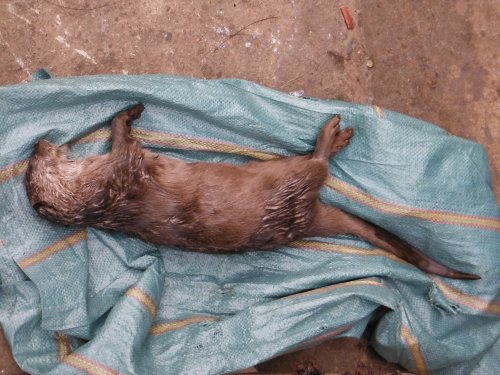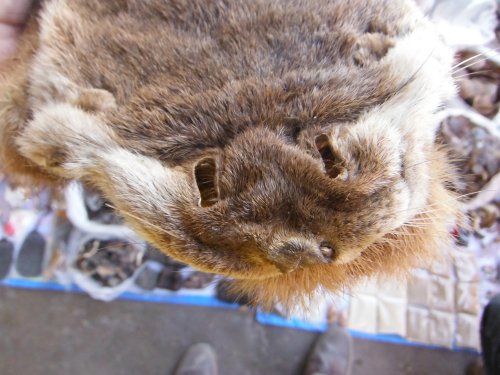IUCN/SSC Otter Specialist Group Bulletin

|
©IUCN/SCC Otter Specialist Group Volume 31 Issue 1 (January 2014) Citation: Shepherd, C.R. and Nijman, V. (2014). Otters in the Mong La Wildlife Market, with a First Record of Hairy-Nosed Otter Lutra sumatrana in Trade in Myanmar. IUCN Otter Spec. Group Bull. 31 (1): 31 - 34 Otters in the Mong La Wildlife Market, with a First Record of Hairy-Nosed Otter Lutra sumatrana in Trade in Myanmar Chris R. Shepherd1 and Vincent Nijman 2
1TRAFFIC and member of the IUCN SSC Otter Specialist Group |
| Received 29th January 2014, accepted 29th Jauary 2014 |
| Abstract: Hunting and trade of otters in South-East Asia is a severe threat to the regional conservation of all four species. During surveys of the wildlife trade in the town of Mong La, Shan State, Myanmar, three species of otters were observed, including a skin of a Hairy-nosed Otter Lutra sumatrana. This is the first record of this species in trade in Myanmar, and the second record of the species in the country. |
| Keywords: Lutra; otter; poaching; wildlife trade |
| Française | Español |
Four species of otters have been recorded from Myanmar, including Small-clawed Otter Aonyx cinereus, Smooth Otter Lutrogale perspicillata, Eurasian Otter Lutra lutra and Hairy-nosed Otter L. sumatrana - the latter recorded for Myanmar from a single museum specimen only ( Duckworth and Hills, 2008 ) and unconfirmed occurrence in the Irrawaddy delta, as illustrated in the map on The IUCN Red List of Threatened Species page ( Hussain et al., 2008 ). Three of these species are considered globally threatened in The IUCN Red List of Threatened Species ( 2013 ):Small-clawed Otter and Smooth Otter are assessed as Vulnerable, Hairy-nosed Otter as Endangered. Eurasian Otter is assessed as Near Threatened.
Otter populations are under rapid decline across most of mainland South-East Asia, largely due to habitat loss and habitat conversion, and due to hunting for trade, to the point where regional extinctions of one or more species is a real possibility ( Duckworth and Hills, 2008 ). In a national-level analysis of small carnivores in Myanmar, otters were considered to be the most severely threatened species ( Than Zaw et al., 2008 ). Of the four species of otter native to Myanmar, only the Hairy-nosed Otter is not protected under the Protection of Wildlife and Wild Plants and Conservation of Natural Areas Law, 1994, because it was not recognised as occurring in Myanmar ( Than Zaw et al., 2008 ).
On 1-2 January 2014, we visited the town of Mong La, Myanmar, to carry out wildlife trade surveys. Mong La is situated in a Special Development Zone in the Shan State adjacent to Yunnan Province, China, and is known to be a significant wildlife trade hub ( Shepherd and Nijman, 2007 ). An inventory of wildlife was carried out in the market (wet market selling fresh produce, fish and freshly hunted animals), wild meat restaurants and retail outlets there on 1 January and of freshly delivered carcasses and live animals in the market again on 2 January, because deliveries of freshly killed animals from hunters are daily (Shepherd and Nijman, in prep.).
Otter parts and carcasses were observed for sale in the market and in one retail outlet, but not in the wild meat restaurants during this survey. In one retail outlet, specialising in wildlife parts mostly for luxury and trophies, an unidentified otter skin was observed for sale. In the market, one complete otter skeleton, two fresh Small-clawed Otter carcasses ( Figure 1 ) and four skins were observed. While three of the skins were not identifiable, the fourth, recognised immediately by the hair-covered rhinarium (short brown fur, slightly lighter in colour than the fur covering the body) was a Hairy-nosed Otter (Figure 2). It was compared with a Small-clawed Otter skin in the pile beside it which further showed the noticeable difference on the nose.
To date, there is only one known record of Hairy-nosed Otter from Myanmar, a specimen collected at Gam Majaw, in Kachin state, northern Myanmar, on 6 April 1939 by Ronald Kaulback, which is currently held in the Natural History Museum, London ( Duckworth and Hills, 2008 ).
While there are some parts of wildlife not native to South-East Asia for sale in the higher-end retail shops in Mong La, such as Tibetan Antelope Pantholops hodgsonii horns, no species not native to Myanmar were observed in the market, which consisted of animals brought in daily by local hunters from the Myanmar side of the border. However, it is not impossible that the Hairy-nosed Otter observed in this market originated elsewhere, though it seems highly unlikely, given that it was in a stack of other otter skins in the market, as opposed to being in a novelty trophy shop.
Poaching is considered to be a threat throughout the range of the Hairy-nosed Otter ( Hussain et al., 2008 ), but this observation constitutes the first record of Hairy-nosed Otter in trade in Myanmar. This apparent contradiction may reflect both the paucity of market surveys in Myanmar and the country’s location at the edge of the species’s range or possibly that otter remains are transported directly to known buyers rather than placed for open sale in markets or some other factor. Concerted efforts to monitor the trade in otters, and to work with the authorities in Myanmar to reduce poaching and trade in otters, are essential. It is also essential that the Government of Myanmar provide full legal protection for the Hairy-nosed Otter, so that future enforcement efforts may benefit this threatened otter.
Acknowledgements - We thank J. W. Duckworth and Richard Thomas for useful comments on an earlier draft. We also thank our donor, who wishes to remain anonymous, for supporting market surveys in the region.
REFERENCES
Duckworth, J.W., Hills, D.M. (2008).
A specimen of Hairy-Nosed Otter Lutra sumatrana from Far Northern Myanmar.
IUCN Otter Spec. Group Bull. 25 (1): 60- 67.
Hussain, S.A., Kanchanasakha, B., de Silva, P.K., Olson, A. (2008).
Lutra sumatrana. In: IUCN 2013. IUCN Red List of Threatened Species. Version 2013.2.
[Available from
http://www.iucnredlist.org
. Downloaded on 03 January 2014]
IUCN (2013). IUCN Red List of Threatened Species. Version 2013.2.
[Available from
http://www.iucnredlist.org
. Downloaded on 03 January 2014]
Shepherd, C. R., Nijman, V. (2007). An assessment of wildlife trade at the Mong La Market on the Myanmar-China Border. TRAFFIC Bulletin , 21(2): 85-88.
Than Zaw, Saw Htun, Saw Htoo Tha Po, Myint Maung, Lynam, A.J., Kyaw Thinn Latt, Duckworth, J.W. (2008). Status and distribution of small carnivores in Myanmar. Small Carnivore Cons. 38: 2-28.
Résumé : Des Loutres en Vente au marché de Mong La avec une Première Donnée d’une Loutre de Sumatra (Lutra sumatrana) en Vente au Myanmar
La chasse et le commerce des loutres en l’Asie du Sud Est représentent une menace sévère pour la conservation locale des quatre espèces de loutres. Lors d’enquêtes sur le commerce des animaux sauvages dans la ville de Mong la, Etat de Shane, Myanmar, trois espèces de loutres ont été observées, dont une peau de loutre de Sumatra (Lutra sumatrana). C’est la première donnée pour le commerce de cette espèce au Myanmar et la seconde pour le pays.
Revenez au dessus
Resumen: Nutrias en el Mercado de Fauna Silvestre Mong La, con un Primer Registro de la Nutria de Sumatra Lutra sumatrana Siendo Comercializada en Myanmar
La caza y el comercio de nutrias en el Sudeste de Asia es una severa amenaza a la conservación regional de las cuatro especies existentes. Durante relevamientos del comercio de fauna silvestre en la ciudad de Mong La, Estade Shane, Myanmar, fueron observadas tres especies de nutrias, incluyendo un cuero de una nutria de Sumatra, Lutra sumatrana. Este es el primer registro de esta especie en el comercio en Myanmar, y el segundo registro de esta especie en el país.
Vuelva a la tapa

